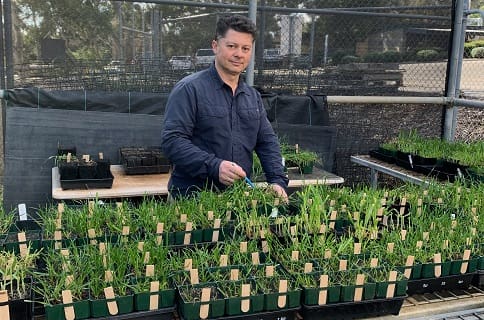HARVEST is an opportune time for southern region grain growers to collect weed seeds for herbicide resistance testing, according to Grains Research and Development Corporation (GRDC) crop protection manager – south, Ruth Peek.
Determining the status of herbicide resistance provides growers with valuable information on the effectiveness of herbicides on target weeds, potentially preventing the wasteful use of ineffective herbicides and reducing the spread of herbicide resistance.
Mrs Peek said results from testing would help inform growers’ integrated weed management strategies ahead of the 2021 cropping season and beyond.
“Herbicide resistance surveys conducted across the southern cropping region have shown that resistance is increasing,” she said.
“It is a costly problem for growers for whom management of weeds and herbicide resistance now requires a year-round, multi-tactic approach.”
Mrs Peek said at this time of the year, testing weed seeds for herbicide resistance enabled growers to obtain a better understanding of the status of herbicide resistance within their paddocks – especially those paddocks where there is a lengthy history of herbicide use and herbicide survivors have been allowed to set seed.

Herbicide resistance researcher Peter Boutsalis, from the University of Adelaide and Plant Science Consulting.
Testing seeds for resistance
Herbicide resistance researcher Peter Boutsalis, from the University of Adelaide and Plant Science Consulting, said collection of samples of weed seeds (for testing levels of resistance) could occur during and even after harvest or cutting crops for fodder. After harvest, weed seed heads were still present in paddocks.
Dr Boutsalis said contaminated grain or header screenings could also be sent for testing as commercial testing services could separate weed seeds from other material.
The method of sampling employed would depend on the resistance situation of each paddock.
“If resistance is widespread, seeds should be collected following a ‘W’ shaped area every 10-20 metres across the suspected paddock or problem area,” he said.
“Alternatively, collect seeds from suspect areas.
“It is important that growers and advisers do not bias the samples by collecting seeds from a small number of plants – they should instead aim to collect a similar number of seeds from each plant.
“Basically, sample areas in the paddock of concern.”
If the seeds are not completely dry, they should be sent in paper envelopes to avoid rotting in plastic packaging.
If growers wish to have annual ryegrass seed tested, about one cup equivalent of clean ryegrass (about 50 seed heads) is required.
“Where there are lots of ryegrass individuals in the paddock, don’t collect from only a few, but try to collect one seed head per plant,” Dr Boutsalis said.
“For species with larger seeds such as wild oats, brome, barley grass and wild radish, an ice-cream container full is sufficient – this is equivalent to an A4 sized envelope full of seeds.”
Dr Boutsalis said it was important to provide sufficient seed to represent the area of interest: “Sending more seed is better than not enough”.
If a paddock contains more than one suspect area, samples from each area should be tested separately because resistance can vary across a paddock.
In the past, testing three or four herbicides of differing modes of action was common, however, with a greater choice of pre-emergence herbicides, the average number of herbicides chosen for testing is now five to six.
Increasing rates of resistance
A long-term GRDC program monitoring herbicide resistance in significant weed species has revealed increasing rates of resistance to a wide range of herbicides.
Dr Boutsalis and researchers from the University of Adelaide collected ryegrass seed from 325 randomly selected paddocks across parts of the southern growing region between October and December 2019.
These were grown in pots and sprayed with herbicides at label rates in May and June 2020.
Dr Boutsalis said herbicide resistance had clearly increased over the program’s 2009, 2014 and 2019 surveys.
The increasing rates of resistance were not restricted to any one herbicide group or region, and as strains with a specific resistance evolved, they quickly established themselves in the local area.
Dr Boutsalis said identifying and keeping herbicide-resistant weeds at manageable levels is essential for the long-term viability of chemical actives such as glyphosate in Australian cropping systems.
“If the weeds grow through to flowering their pollen can disperse resistance genes over a wide area. Resistance genes are also spread in seeds via contaminated machinery, grain and livestock,” he said.
“Undetected resistance on one farm can lead to that strain getting established, which creates a problem for surrounding paddocks.
“Growers who are aware of their resistance problems know to focus on tactics such as harvest weed seed control and double-knock spraying. If they control every glyphosate survivor with alternative tactics over the next two seasons, they should be able to significantly reduce weed populations.”
Source: GRDC
Weed seeds collected at harvest time can be sent for testing over summer and reporting in early autumn. Weed seed resistance testing services are available via:
Peter Boutsalis, Plant Science Consulting, Adelaide (SA). Phone 0400 664460, email [email protected], web http://www.plantscienceconsulting.com.au
John Broster, Charles Sturt University, Wagga Wagga (NSW). Phone (02) 6933 4001, email [email protected], web https://www.csu.edu.au/weedresearchgroup/herbicide-resistance.
More information on herbicide resistance and weed management is available via the GRDC’s Integrated Weed Management Manual at https://grdc.com.au/IWMM and the GRDC-supported WeedSmart resource centre at http://www.weedsmart.org.au.
WeedSmart is the ‘single industry’ multi-channel platform for information on combating cropping weeds and herbicide resistance in Australia.

HAVE YOUR SAY